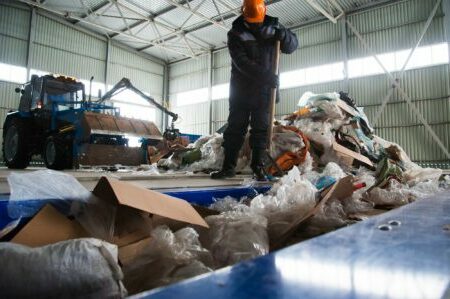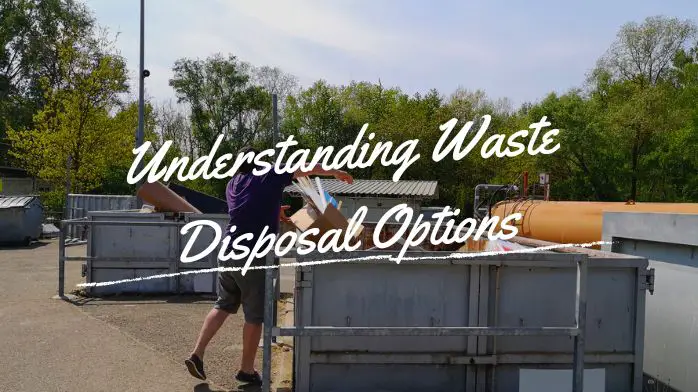Waste disposal is the process of removing unwanted materials that are no longer useful or needed. There are several options for waste disposal, including landfills, recycling centers, and incineration.
Landfills are sites where waste is disposed of in a controlled manner. They are often used for the disposal of household and industrial waste.
Landfills are designed to minimize the environmental impact of waste, but they are not a perfect solution. Landfills can release harmful gases into the air, and they can also contaminate the soil and water.
Recycling centers are facilities that process materials that can be used again. These materials may include paper, plastic, metal, and glass. Recycling can reduce the amount of waste that goes into landfills and conserve natural resources by using fewer raw materials to produce new products.
Incineration is the process of burning waste to generate energy. It can be used to dispose of waste unsuitable for recycling, such as plastic and rubber. Incineration reduces the volume of waste, but it can also release harmful emissions into the air.
There are pros and cons to each of these waste disposal options, and the best solution will depend on the community’s specific needs. It is important to consider the environmental impact of waste disposal and to find ways to minimize it.
Landfills
Landfills are sites where waste is disposed of in a controlled manner. They are typically used for the disposal of household and industrial waste. Landfills are designed to minimize the environmental impact of waste, but they are not a perfect solution. Landfills can release harmful gases into the air, and they can also contaminate the soil and water.
There are several types of landfills, including:
- Municipal solid waste landfills: These landfills are used to dispose of household waste, such as food scraps and packaging materials.
- Industrial landfills: These landfills are used to dispose of industrial waste, such as chemicals and hazardous materials.
- Construction and demolition landfills: These landfills are used to dispose of construction and demolition debris, such as concrete and wood.
To minimize the environmental impact of landfills, waste is often placed in a lined pit and covered with a layer of soil after each day of disposal. This helps to prevent contamination of the soil and water. Landfills are also required to have systems in place to collect and treat leachate, which is the liquid that is produced when waste decomposes.
Despite these measures, landfills can still have negative impacts on the environment. They can release methane and other harmful gases into the air and contribute to water pollution if not properly managed. As a result, many communities are looking for alternative waste disposal methods, such as recycling and composting.

Household and Industrial Waste
Households produce household waste, including food scraps, packaging materials, and household products. Industrial waste is produced by industrial activities such as manufacturing, construction, and mining. The industrial waste can include hazardous materials, such as chemicals and batteries, and non-hazardous materials, such as concrete and wood.
There are several household and industrial waste disposal options, including landfills, recycling centers, and incineration. Landfills are the most common method of waste disposal. Still, they can have negative environmental impacts, such as releasing harmful gases into the air and contaminating soil and water. Recycling centers process materials that can be used again, such as paper, plastic, metal, and glass. Incineration is the process of burning waste to generate energy, but it can release harmful emissions into the air.
It is important to properly manage household and industrial waste to minimize its environmental impact. This can include reducing the amount of waste produced, recycling materials that can be reused, and properly disposing of hazardous materials.
Recycling Centers
Recycling centers are facilities that process materials that can be used again. These materials may include paper, plastic, metal, and glass. Recycling centers collect, sort, and process these materials, which are then used to produce new products.
Recycling has several benefits. It reduces the amount of waste that goes into landfills and incineration, which can help minimize waste disposal’s environmental impact. Recycling conserves natural resources by using fewer raw materials to produce new products. For example, recycling aluminum uses 95% less energy than producing new aluminum from raw materials.
There are several types of recycling centers, including:
- Single-stream recycling centers: These centers allow all recyclable materials to be mixed rather than separated by type.
- Drop-off recycling centers: These centers allow individuals to bring their recyclable materials to a central location to be processed.
- Curbside recycling programs: These programs allow individuals to place their recyclable materials in a container that is picked up by a recycling truck.
Following the guidelines for your specific recycling program is important to recycle materials effectively. This may include separating materials by type, rinsing containers, and removing lids and caps.
Recycling can help reduce the environmental impact of waste, but reducing the amount of waste produced is also important. This can be achieved by using reusable products, such as cloth bags and water bottles, and properly disposing of hazardous materials.
Recyclable Material
Recyclable materials can be collected, processed, and used to produce new products. Some common recyclable materials include:
- Paper: This includes newspapers, magazines, cardboard, and office paper.
- Plastic: This includes plastic bottles, containers, and packaging materials.
- Metal: This includes aluminum, steel, and copper.
- Glass: This includes bottles and jars.
- Electronics: This includes computers, cell phones, and appliances.
- Textiles: This includes clothing, towels, and sheets.
- Batteries: This includes household batteries and car batteries.
Recycling programs may have different guidelines for the types of materials that they accept, so it is important to check with your local recycling center to determine what materials are accepted.
In addition to these common recyclable materials, many other materials, such as rubber, wood, and construction debris, can be recycled. Recycling these materials can help reduce waste in landfills and conserve natural resources by using fewer raw materials to produce new products.
Incineration
Incineration is the process of burning waste to generate energy. It is often used to dispose of waste unsuitable for recycling, such as plastic and rubber. Incineration reduces the volume of waste by burning it, which can be beneficial in areas with limited space for waste disposal.
During incineration, waste is burned at high temperatures, typically over 1000 degrees Celsius. The heat produced by the burning waste is used to generate steam, which can be used to generate electricity. Incineration can also sterilize medical waste, such as needles and syringes.
Incineration has several benefits, including the reduction of waste volume and the generation of energy. However, it also has some drawbacks. Incineration can release harmful emissions into the air, such as dioxins and particulate matter. These emissions can be harmful to human health and the environment. In addition, incineration can be expensive to operate, requiring a constant supply of waste to be effective.
There are several types of incineration facilities, including mass burn facilities, which burn mixed waste, and resource recovery facilities, which burn specific types of waste, such as municipal solid waste or hazardous waste.
Incineration is just one option for waste disposal, and it is important to consider this method’s environmental and economic impacts. Alternative waste disposal methods, such as recycling and composting, may be more sustainable and cost-effective in some cases.
Burnable Material
Burnable material is material that can be burned to generate energy. This can include many materials, such as wood, paper, and plastic. Burnable material can be used as fuel for heating or generating electricity through incineration.
Some materials are more suitable for burning than others. Wood and paper are common burnable materials because they burn easily and produce a large amount of heat. Plastic is also burnable but can release harmful emissions, such as dioxins and particulate matter.
In addition to household and industrial waste, other sources of burnable material include biomass, such as wood chips and agricultural waste, and fossil fuels, such as coal and natural gas.
Burnable material is a source of energy, but it is important to consider the environmental impact of burning. Burning fossil fuels, such as coal and oil, can release large amounts of carbon dioxide, a greenhouse gas contributing to climate change. The burning of biomass can also release carbon dioxide. Still, it is generally considered a more sustainable energy source because the absorption of carbon dioxide offsets the carbon dioxide emissions by the plants as they grow.
Conclusion
In conclusion, waste disposal removes unwanted materials that are no longer useful or needed. There are several options for waste disposal, including landfills, recycling centers, and incineration. Landfills are sites where waste is disposed of in a controlled manner. Still, they can have negative environmental impacts, such as releasing harmful gases and contaminating soil and water. Recycling centers process materials that can be used again, such as paper, plastic, metal, and glass. Incineration is the process of burning waste to generate energy, but it can release harmful emissions into the air.
It is important to properly manage household and industrial waste to minimize its environmental impact. This can include reducing the amount of waste produced, recycling materials that can be reused, and properly disposing of hazardous materials. Recycling and composting are alternative methods of waste disposal that can be more sustainable and cost-effective in some cases.

